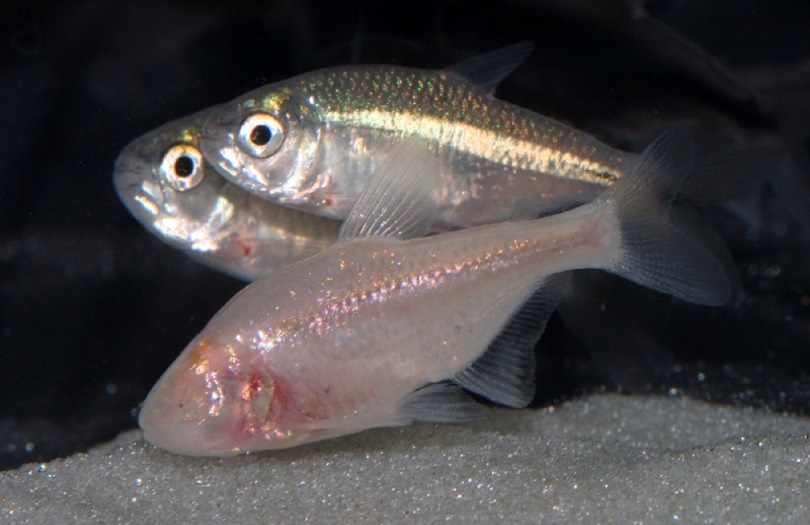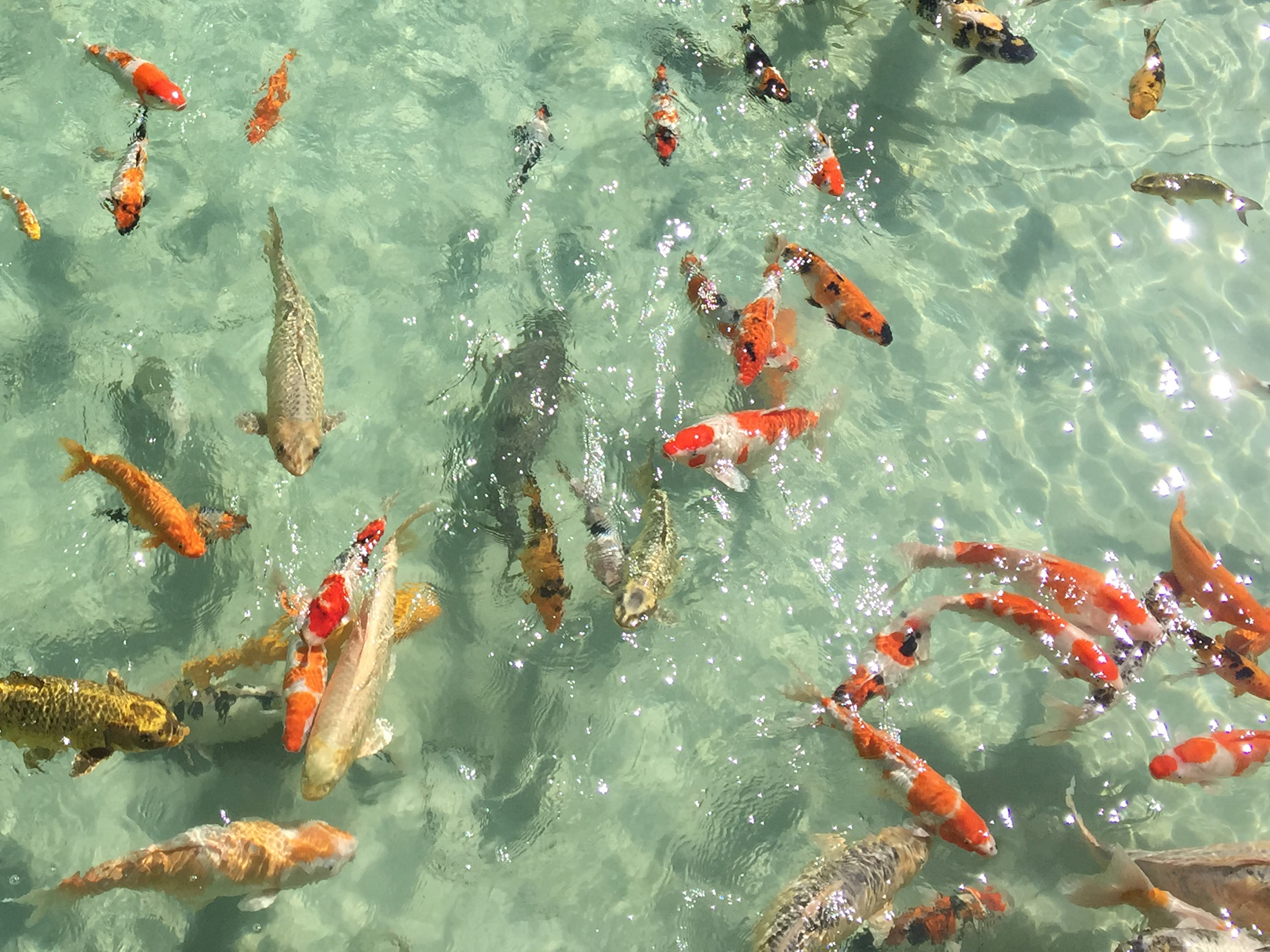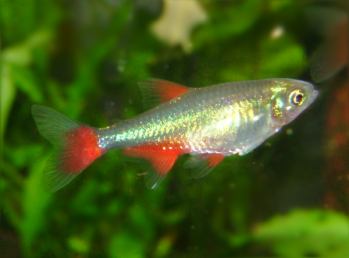|
Tetras
Tetra is the common name of many small freshwater characiform fishes. Tetras come from Africa, Central America, and South America, belonging to the biological families Characidae, Alestidae (the "African tetras"), Lepidarchidae, Lebiasinidae, Acestrorhynchidae, Stevardiidae, and Acestrorhamphidae. In the past, all of these families were placed in the Characidae. The Characidae and their allies are distinguished from other fish by the presence of a small adipose fin between the dorsal and caudal fins. Many of these, such as the neon tetra (''Paracheirodon innesi''), are brightly colored and easy to keep in captivity. Consequently, they are extremely popular for home aquaria. ''Tetra'' is no longer a taxonomic, phylogenetic term. It is short for ''Tetragonopterus'', a genus name formerly applied to many of these fish, which is Greek for "square-finned" (literally, four-sided-wing). Because of the popularity of tetras in the fishkeeping hobby, many unrelated fish are c ... [...More Info...] [...Related Items...] OR: [Wikipedia] [Google] [Baidu] |
Neon Tetra
The neon tetra (''Paracheirodon innesi'') is a freshwater fish of the characin family (family Characidae) of order Characiformes. The type species of its genus, it is native to blackwater and clearwater streams in the Amazon basin of South America. Its bright colouring makes the fish visible to conspecifics in the dark blackwater streams, and is also the main reason for its popularity among freshwater fish hobbyists, with neon tetras being one of the most widely kept tropical fish in the world. Range and habitat The neon tetra is found in the western and northern Amazon basin in southeastern Colombia, eastern Peru, and western Brazil. It lives in waters with a temperature between and pH 4–7.5. It has a preference for acidic blackwater streams, but also occurs in transparent clearwater streams. It is not found in the whitewater rivers. UN FAO considers ''P. innesi'' an introduced species in Singapore and the United States. FAO considers its introduction to Singapore t ... [...More Info...] [...Related Items...] OR: [Wikipedia] [Google] [Baidu] |
Black Neon Tetra
The black neon tetra (''Hyphessobrycon herbertaxelrodi'') is a freshwater fish of the characin family (Characidae) of the order Characiformes. It is native to the Paraguay basin of southern Brazil. They are often found in the aquarium trade, and a feral population has been established in the rio Paraíba do Sul basin due to the trade. Taxonomy The species is named in honor of pet-book publisher Herbert R. Axelrod (1927–2017), whose Tropical Fish Hobbyist magazine published this description and several others by Géry. Description This species is of typical elongated tetra appearance; it is of plain basic coloration, but with two distinct, adjacent, longitudinal stripes; white above black. The eye has two thin but distinctive color bands across the top; red above yellow. It grows to a maximum overall length of approximately . Befitting its common name, it slightly resembles the neon tetra, which belongs to a different genus ('' Paracheirodon''). Females are often larger than ... [...More Info...] [...Related Items...] OR: [Wikipedia] [Google] [Baidu] |
Acestrorhamphidae
Acestrorhamphidae, the American tetras, are a diverse family of freshwater fish in the order Characiformes. They are native to North and South America, from the southwestern United States south to temperate Argentina, with a few species introduced to other parts of the world. It includes many genera previously placed in the family Characidae, which was split into multiple families in 2024. It contains many of the most famous ornamental aquarium fish that are popularly known as tetras. Taxonomy The following taxonomy is based on ''Eschmeyer's Catalog of Fishes'': Family Acestrorhamphidae * Subfamily Oxybryconinae Melo, Mattox & Oliveira, 2024 ** '' Oxybrycon'' Géry, 1964 * Subfamily Trochilocharacinae Melo, Mattox & Oliveira, 2024 (hummingbird characins) ** '' Trochilocharax'' Zarske, 2010 * Subfamily Stygichthyinae Géry, 1972 ** '' Coptobrycon'' Géry, 1966 ** '' Deuterodon'' Eigenmann, 1907 ** '' Myxiops'' Zanata & Akama, 2004 ** '' Stygichthys'' Brittan & Böhlke, 1 ... [...More Info...] [...Related Items...] OR: [Wikipedia] [Google] [Baidu] |
Stevardiidae
Stevardiidae is a large family of freshwater fish in the order Characiformes. It includes many genera previously placed in the family Characidae, which was split into multiple families in 2024. They are found throughout South and Central America. In earlier taxonomic treatments, most genera in this family were placed in the characid subfamily Glandulocaudinae, which has been redefined as a much smaller subfamily of the Stevardiidae. As suggested by their former taxonomic name, a gland on their caudal fin is found almost exclusively in the males of many species of this family, which allows the release and pumping of pheromones. Members of this subfamily have complex courtship behaviors which lead to insemination. The ecology and life history of these fish is complex yet little studied. Stevardiids are important components of the diet for commercially-harvested larger fish. Taxonomy The following taxonomy is based on '' Eschmeyer's Catalog of Fishes'': Family Stevardiidae * S ... [...More Info...] [...Related Items...] OR: [Wikipedia] [Google] [Baidu] |
Acestrorhynchidae
Acestrorhynchidae is a family of freshwater fish in the order Characiformes, found in South America. Members of this family are known as freshwater barracudas (not to be confused with the unrelated true barracudas of the Sphyraenidae) and biting tetras. Until recently, this family contained only the genus '' Acestrorhynchus''. However, taxonomic studies have found that the subfamilies Heterocharacinae (originally placed in the closely related Characidae) and Roestinae (originally placed in the more distantly related Cynodontidae) are actually more closely related to ''Acestrorhynchus'', and now they are also placed in this family. The family is classified as follows: * Family Acestrorhynchidae ** Subfamily Acestrorhynchinae Eigenmann, 1912 (freshwater barracudas) *** Genus '' Acestrorhynchus'' Eigenmann & Kennedy, 1903 ** Subfamily Roestinae Lucena & Menezes, 1998 (biting tetras) *** Genus '' Gilbertolus'' Eigenmann, 1907 *** Genus '' Roestes'' Günther, 1864 ** Subfamily ... [...More Info...] [...Related Items...] OR: [Wikipedia] [Google] [Baidu] |
Alestidae
African tetras (family (biology), family Alestidae, formerly spelled Alestiidae) are a group of Characiformes, characiform fish found exclusively in Africa. This family contains about 18 genera and 119 species. Among the best known members are the Congo tetra, and Hydrocynus, African tigerfish. Although presently found only in Africa, fossil evidence suggests that during the Paleogene, they ranged as far north as southern Europe and as far east as the Arabian subcontinent. Fossil remains date back to potentially the Late Paleocene with ''Hydrocynus'' remains known from Algeria. Alestid-like teeth are also known from the Late Cretaceous (Maastrichtian) of France, and phylogenetic evidence also suggests they diverged around this time. Taxonomy Taxonomy based on Van der Laan 2017 and ''Eschmeyer's Catalog of Fishes'' (2025): * Family Alestidae Cockerell, 1910 ** Genus ''Alestes'' Johannes Peter Müller, Müller & Franz Hermann Troschel, Troschel, 1844 ** Genus ''Alestion'' Tyson R ... [...More Info...] [...Related Items...] OR: [Wikipedia] [Google] [Baidu] |
Tetragonopterus
''Tetragonopterus'' is a genus of fish in the family Characidae native to South America. It is the only member of the subfamily Tetragonopterinae. The subfamily was originally much larger as previously defined, and contained many of the genera known as " tetras". The name "tetra" derives from this former classification. Species There are currently 14 recognized species of this genus: * '' Tetragonopterus anostomus'' G. S. C. Silva & Benine, 2011 Silva, G.S.C. & Benine, R.C. (2011)A new species of ''Tetragonopterus'' Cuvier, 1816 (Characiformes, Characidae, Tetragonopterinae) from the upper rio Araguaia, Central Brazil.''Zootaxa, 2911: 50–56.'' * '' Tetragonopterus araguaiensis'' G. S. C. Silva, B. F. Melo, C. de Oliveira & Benine, 2013 Silva, G.S.C., Melo, B.F., Oliveira, C. & Benine, R.C. (2013)Morphological and molecular evidence for two new species of ''Tetragonopterus'' (Characiformes: Characidae) from central Brazil.''Journal of Fish Biology, 82 (5): 1613-1631.'' * ... [...More Info...] [...Related Items...] OR: [Wikipedia] [Google] [Baidu] |
Fishkeeping
Fishkeeping is a popular hobby, practiced by aquarists, concerned with keeping fish in a home aquarium or garden pond. It is a practice that encompasses the art of maintaining one's own aquatic ecosystem, featuring a lot of variety with various water systems, all of which have their own unique features and requirements. Fishkeeping primarily serves as a token of appreciation and fascination for marine life and the environment that surrounds such, along with other purposes such as the pisciculture, piscicultural fishkeeping industry, serving as a branch of agriculture, being one of the most widespread methods of cultivating fish for commercial profit. Origins of fishkeeping Fish have been raised as food in pools and ponds for thousands of years. Brightly colored or tame specimens of fish in these pools have sometimes been valued as pets rather than food. Many cultures, ancient and modern, have kept fish for both functional and decorative purposes. Ancient Sumerians kept wild-c ... [...More Info...] [...Related Items...] OR: [Wikipedia] [Google] [Baidu] |
Hyphessobrycon
''Hyphessobrycon'' is a genus of freshwater fish in the family (biology), family Characidae. These species are among the fishes known as tetras. The genus is distributed in the Neotropical realm from southern Mexico to Río de la Plata in Argentina. Many of these species are native to South America; about six species are from Central America and a single species, ''Hyphessobrycon compressus, H. compressus'' is from southern Mexico. All small fishes, the ''Hyphessobrycon'' tetras reach maximum overall lengths of about . Great anatomical diversity exists in this genus. They are generally of typical characin shape, but vary greatly in coloration and body form, many species having distinctive black, red, or yellow markings on their bodies and fins. These species are generally omnivorous, feeding predominantly on small crustaceans, insects, annelid worms, and zooplankton. When spawning, they scatter their eggs and guard neither eggs nor young. Taxonomy This large genus of characins in ... [...More Info...] [...Related Items...] OR: [Wikipedia] [Google] [Baidu] |
Lebiasinidae
The Lebiasinidae are a family (biology), family of freshwater fishes found in Costa Rica, Panama, and South America. They are usually small and are known as ornamental fishes in Aquarium, aquaria, including popular fishes such as the various pencil fish, pencilfish and the splashing tetra. Lebiasinids are small, cylindrical fish, ranging from in adult length. They prey on insect larvae, especially those of mosquitos. The family includes the voladoras (genera ''Lebiasina'' and ''Piabucina''), mostly found in highlands of the north Andes, the Guiana Shield and Central America, but the other species are mainly lowland fish inhabiting the Orinoco, Amazon basin, Amazon and Paraguay River basins, and rivers of the Guianas. Genera Around 67 species are placed in these genus, genera: * Subfamily Lebiasininae Gill, 1889 - lebiasinas or voladoras ** ''Derhamia'' Jacques Géry, Géry & Axel Zarske, Zarske, 2002 (one species) **''Lebiasina'' Achille Valenciennes, Valenciennes, 1847 (12 spe ... [...More Info...] [...Related Items...] OR: [Wikipedia] [Google] [Baidu] |
Characidae
Characidae, the characids, is a family of freshwater subtropical and tropical fish belonging to the order Characiformes. They are found throughout much of Central and South America, including such major waterways as the Amazon and Orinoco Rivers.Nelson (2006) These fish vary in length; many are less than . The name " characins" is a historical one, but scientists today tend to prefer "characids" to reflect their status as a, by and large, monophyletic group (at family rank). This family includes some of the first characiforms to be described to science, such as '' Charax'' and '' Tetragonopterus'', and thus lend their name to the order, as well as to common names such as "characin" and " tetra". Past taxonomic treatments had a much more expansive definition of the family, including numerous South American fish families such as the piranhas and dorados, as well as the African alestids. Following multiple taxonomic revisions, this was eventually restricted to just the Americ ... [...More Info...] [...Related Items...] OR: [Wikipedia] [Google] [Baidu] |
Alestiidae
African tetras (family (biology), family Alestidae, formerly spelled Alestiidae) are a group of Characiformes, characiform fish found exclusively in Africa. This family contains about 18 genera and 119 species. Among the best known members are the Congo tetra, and Hydrocynus, African tigerfish. Although presently found only in Africa, fossil evidence suggests that during the Paleogene, they ranged as far north as southern Europe and as far east as the Arabian subcontinent. Fossil remains date back to potentially the Late Paleocene with ''Hydrocynus'' remains known from Algeria. Alestid-like teeth are also known from the Late Cretaceous (Maastrichtian) of France, and phylogenetic evidence also suggests they diverged around this time. Taxonomy Taxonomy based on Van der Laan 2017 and ''Eschmeyer's Catalog of Fishes'' (2025): * Family Alestidae Cockerell, 1910 ** Genus ''Alestes'' Johannes Peter Müller, Müller & Franz Hermann Troschel, Troschel, 1844 ** Genus ''Alestion'' Tyson R ... [...More Info...] [...Related Items...] OR: [Wikipedia] [Google] [Baidu] |





